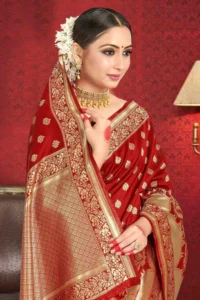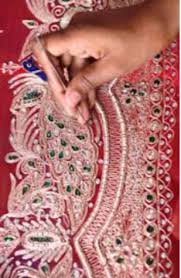BANARASI SAREE
The Banarasi saree is a timeless symbol of Indian craftsmanship, originating from Varanasi, Uttar Pradesh. Known for its rich silk material and problematic weaving, those sarees are famend for their costly enchantment and cultural significance. Traditionally embellished with gold and silver zari work, Banarasi sarees often characteristic motifs stimulated through nature, Mughal artwork, and Hindu mythology. Worn in the course of unique occasions like weddings and gala’s, they exude elegance and style. The meticulous craftsmanship and first rate designs make Banarasi sarees a prized possession for any lady, representing both background and the greatest of textile artistry.

The Banarasi saree is one of the most iconic traditional garments in India, known for its intricate craftsmanship, luxurious silk fabric, and rich history. Originating from the holy city of Varanasi (Banaras), the Banarasi saree has become synonymous with elegance, culture, and tradition. The saree is famous for its elaborate weaving techniques, often incorporating motifs inspired by Mughal art, nature, and Hindu mythology. It is typically woven with fine silk and embellished with intricate zari (gold or silver thread) work, making it a symbol of opulence.
Banarasi sarees have become a traditional saree choice due to their deep cultural significance. They are primarily worn during weddings, religious ceremonies, and festivals, where the intricate designs and rich textures make them perfect for such occasions. The traditional weaving process, which includes handloom techniques passed down through generations, adds a unique touch of craftsmanship that sets the Banarasi saree apart from others. The Banarasi saree embodies the spirit of Indian heritage and is revered for its timeless appeal.
Over the years, the Banarasi saree has evolved, with new variants like Georgette, Katan, and Tissue Banarasi sarees becoming popular. Despite modern variations, the Banarasi saree remains the epitome of traditional Indian fashion, representing grace, elegance, and the rich textile history of India.
PROCESS OF PREPARE BANARASI SAREE

The process of making a Banarasi saree is a time-consuming and intricate procedure that involves multiple steps, each requiring skill and expertise. This traditional craft, passed down through generations, results in one of the most luxurious sarees in India. Creating a Banarasi saree is an problematic system that involves skilled craftsmanship, attention to detail, and conventional weaving techniques. The technique begins with choosing terrific silk threads, which might be the muse of any Banarasi saree. These threads are dyed in vibrant colorations to create the favored aesthetic for the saree.
The saree is woven on a handloom system, which is important to the advent of the Banarasi saree. The handloom gadget makes use of a sequence of spools and shuttles to interlace the silk threads into a cloth. In Banarasi saree making, the handloom is used to create intricate zari work with gold or silver threads. This zari paintings is woven into the material through the intricate weaving approach, which offers the saree its opulent look.
Handmade designs at the Banarasi saree are a trademark of its authenticity. The artisans carefully craft motifs like paisleys, floral patterns, and mughal-inspired designs using both traditional hand-weaving techniques and embroidery. Each motif is meticulously embroidered by hand, making the saree simply one-of-a-type.
The weaving technique can take several weeks, depending at the complexity of the layout. After the material is woven, it’s far dyed and completed to perfection. The final step includes including the border and the pallu, which might be frequently the most ornate components of the saree, showcasing elaborate designs and colourful colours.
The result is a stunning Banarasi saree that embodies both beauty and culture, representing the wealthy heritage of Indian craftsmanship exceeded down through generations.
Step 1: Choosing the Material
The process begins with selecting high-quality silk threads, which are the foundation of the Banarasi saree. The silk is often sourced from regions known for their rich, soft texture. In some cases, a blend of silk and cotton is used. These threads are dyed in various colors to create the vibrant palette that Banarasi sarees are famous for.

Step 2: Designing the Pattern
Designing the pattern is a crucial step in the creation of a Banarasi saree. Traditional motifs like paisleys, floral patterns, and Mughal-inspired art are meticulously chosen. Modern variations might include geometric designs, but the classical elements remain predominant. Artisans sketch these patterns on paper, which are then transferred onto the fabric.

Step 3: Weaving on Handloom
The saree is woven on a handloom machine, where skilled artisans use a traditional loom to weave the silk threads into fabric. This process can take several days or weeks, depending on the intricacy of the design. The weaving often involves zari (gold or silver thread), which is woven into the fabric to add an element of luxury.

Step 4: Adding Zari Work
The zari work, which is an integral part of Banarasi sarees, is woven by hand onto the fabric. It can cover the entire saree or just the border and pallu (the loose end of the saree). The zari adds a shimmering effect, enhancing the beauty of the design

Step 5: Final Touches
Once the saree is woven, it undergoes finishing touches. The edges are neatly sewn, and the fabric is washed to soften it. Afterward, the saree is pressed, folded, and ready for wear, showcasing the stunning craftsmanship that went into its making.
The result is a Banarasi saree that combines tradition, elegance, and artistry, making it a cherished piece in every wardrobe.
